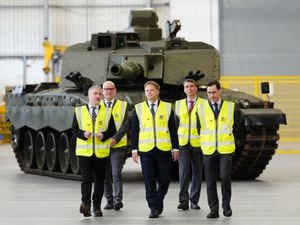Shropshire border observatory backs Nasa asteroid collision warning
Earth is unprepared if an asteroid was to strike the planet, an expert based at an observatory on the Shropshire border has warned.

Jay Tate, director at The Spaceguard Centre near Knighton, said although Nasa was doing a "great job" in detection, he believes the agency needs more help from other organisations.
It comes as Nasa scientist Dr Joseph Nuth warned members at the annual meeting of the American Geophysical Union this week, that humans are not prepared for an asteroid impact.

Former MP Lembit Opik today backed Nasa plans for an interceptor rocket to knock incoming asteroids and comets off course in a bid to protect Earth from Armageddon.
The former MP for Montgomeryshire warns that if an asteroid hit Shropshire it would incinerate everything in its path.
And he agrees with a Nasa scientist who warned that the Earth is woefully unprepared for any such impact from a comet or asteroid.
Lembit, who has long campaigned for action to protest the Earth from asteroids, said: "We are sleepwalking our way to Armageddon. Nasa is right – I have been banging on about this for 20 years, like my grandfather who was an astronomer, before me.
"It may sound like sci-fi talk and a Hollywood movie – but an asteroid has hit Earth before and it will happen again, I predict, within 80 years or so.
"About 1,000 people were injured when a meteor hit Siberia in 2013 and if it had have been bigger, thousands of people would have died. But because it sounds like something from a movie, politicians have been treating it like a joke.
"And in 1908 there was another impact in an unpopulated area of Siberia.
"If we don't do something soon millions of people could be killed and I probably won't be here to say 'I told you so'.
"If Telford was hit, everyone would be incinerated within a radius out to Shrewsbury. Not doing anything is like hearing about a killer disease and not searching for a cure."
"Where are all the dinosaurs now?
"We and the whole of civilisation could be next in line for extinction, it's all a matter of time."
Lembit called for increased political and financial support for tracking space debris at UK Spaceguard in Knighton, Mid Wales and for practical ways to deflect incoming threats.
And, gloomily, if one should head for Earth there's not much we can do about it.
Today Mr Tate says: "I agree, we certainly aren't ready, that's crystal clear.
"The bottom line is, this is a real problem that's facing us but it can be fixed."
The Spaceguard Centre, on Stonewall Hill in Knighton is a working observatory. It became the National Near Earth Objects Information Centre in 2013 and provides information to space agencies and the government. Near Earth objects are asteroids and comets that come close to, and sometimes collide with, the Earth.
Mr Tate said the centre was big on educating people and was open to the public.
It is now looking to focus its attention on a search programme, concentrating on comets as well as asteroids.
Mr Tate said: "Nasa is doing a great job with the detection side, and it was going to be testing a deflection system but last week the European Space Agency decided not to take part. No reason was given but I assume it was down to money.
"The thing is, you have got to be there to stop it and for that you need some sort of system in place. The whole process is simple really. Once something is found, it doesn't take long to decide whether or not it's a problem, then it's a case of deflection.
"Nasa have been doing a good job for the past 20 years but could do with more help from other agencies."
While dangerous asteroids and comets rarely hit Earth, Dr Nuth warned that the threat was always there.
He said: "They are the extinction-level events, things like dinosaur killers, they're 50 to 60 million years apart, essentially.
"You could say, of course, we're due, but it's a random course at that point."
In the past, comets have come very close to hitting Earth.
Dr Nuth said that Earth's best hope was building an interceptor rocket to keep in storage that could be used in deflection missions, but that technology was still some way off.





